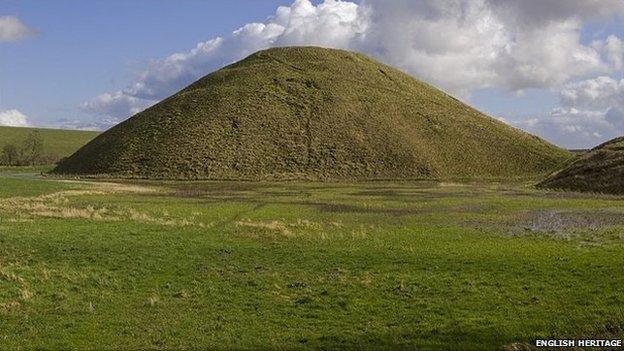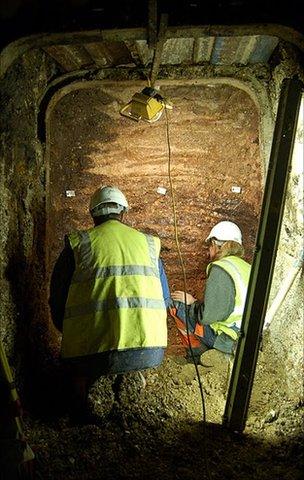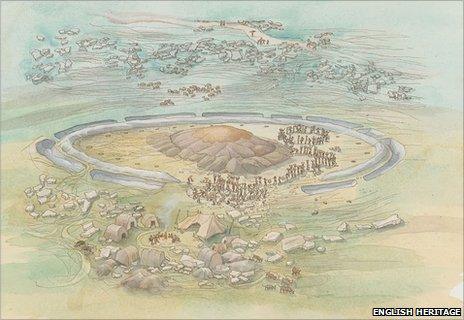Silbury Hill's Anglo-Saxon makeover
- Published

The steep sides and flat top of Silbury Hill may be newer than thought
Silbury Hill acquired its distinctive shape in more modern times, according to new archaeological evidence.
It is traditionally thought that the hill, with its steep banks and flat top, was conceived and completed in pre-historic times.
But new research presented in a new book suggests the final shape was a late Anglo-Saxon innovation.
The hill, near Avebury in Wiltshire, is Europe's largest man-made prehistoric mound.
Archaeologist Jim Leary describes what was found inside Silbury Hill
Saxon summit
According to Jim Leary, the author of The Story of Silbury Hill, the latest archaeology suggests the hill was adapted as a defensive position in the late Anglo-Saxon period.
"The banks of the hill consist of remnants of the Neolithic plus some degree of Anglo-Saxon modification," he told the BBC. "The top of the hill was definitely modified in the medieval period, probably around the year 1000".
A massive post hole found on top of the hill during recent work suggests a wooden palisade crowned the summit during Saxon times, with the interior housing either a small fort or a beacon.
Mr Leary believes the Saxons may have been protecting themselves from Viking incursions, with the hill standing next to a Roman road which invaders could have used.

The new theories are based on new archaeological evidence from deep within the hill
The new book is based on the latest surveys of the hill, including a partial re-excavation of a tunnel dug between 1968 and 1970 by the archaeologist Richard Atkinson.
The Atkinson dig was followed in a series of pioneering live BBC broadcasts fronted by Magnus Magnusson.
Mr Leary says samples taken from the Atkinson tunnel suggest the hill was created not in three stages as previously suggested, but in 15 distinct phases involving some three generations between 2400 and 2300BC.
He believes the people who built it were not concerned with the final shape, but with the ritual of building the structure.
"The received wisdom was the hill was constructed as a single construct. We had this idea that there was a blueprint," Mr Leary told BBC News.
"What was the most remarkable thing about us going into the tunnel was that it wasn't a single construction. It was actually made up of lots of tiny phases.
"It seems as if the hill developed organically and the strangest thing is that this hasn't always been a hill. The first phases of it were a bank and ditch enclosure, much like a henge monument."
Chalk and antlers
Detailed analysis of the structure points to an ongoing process of ritual construction. The archaeological evidence suggests chalk, stones, gravel and turf were consistently used to create textures and patterns.

An artist's impression of how the site may have appeared in pre-historic times
The stone-age Britons who built the original structure also appear to have been armed with little more than antlers crafted into picks.
"The actual process appears to be more important than the construction. The people who started work at Silbury Hill could never have known that it would have ended up the size it is today and that really is a change from what we've previously believed."
Mr Leary believes this process of construction might have been a means by which peoples from across a much broader area came together. Soils found within the hill seem to come from different areas, and could have been brought to the site by various communities.
The 2007-2008 re-excavation of the Atkinson tunnel was part of efforts to shore up and repair the mound. This included filling in a hole which appeared in the hill's summit in 2000 after a shaft dug back in the 18th century collapsed. The 2007-2008 works also resulted in a more minor collapse.
All known tunnels through the structure have now been filled in and the mound re-sealed for generations to come.